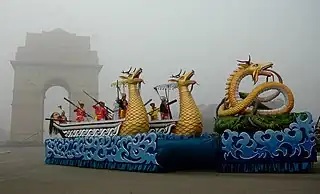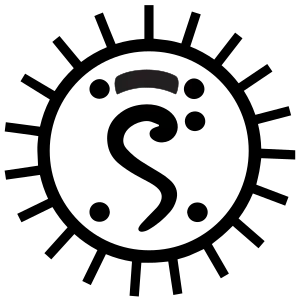Meitei dragons
The dragons play a significant role in the legendary accounts of Meitei folklore, Meitei literature, Meitei mythology and Meitei religion (Sanamahism) of Ancient Kangleipak (Ancient Manipur), Medieval Kangleipak (Medieval Manipur) and Modern Kangleipak (Modern Manipur).[1][2][3]
| Part of a series on |
| Meitei mythology |
|---|
 |
|
|
| Part of a series on |
 |
| Sanamahism |
| Category |
| Primordial deities |
|---|
| Saiyon Langgon |
| Religious texts |
| Religious Symbolism |
|
| Ancient Sites in Manipur |
|
| List of figures in Meitei mythology |
| Religious roles |
| Religious buildings & institutions |
| Religious festivals |
| Lai Halaopa and its holy dances |
| Sanamahism & other religions |
| Related topics |
List
- The Hiyang Hiren (Old Manipuri: Hiyang Hilen) is a well furnished race boat. This is often built in the shape of a dragon. Many legends say that it possesses spiritual powers.
- Kangla Sha is the Guardian dragon lion, safeguarding the Kangla Palace. Kangla Sha are usually depicted in pairs.
- Nongshaba, the dragon lion, is a child of Atingkok, the Supreme Being. Unlike his siblings, he always remains in the form of the mythical beast rather than that of a God (human figure).[3][1][4]
- Pakhangba is the youngest son of Leimarel Sidabi, the supreme mother earth goddess. He was given the throne of the universe to protect and rule the world by Atingkok, his father. He could change himself into both a serpentine dragon and a human. Several legends revolve around his identity as an ancient historical figure.[5][6][7]
- Poubi Lai is the tyrant dragon serpent of the primitive Loktak Lake. This huge dragon is a popular figure in Meitei folklore and mythology.[8][9]
- Taoroinai (Old Manipuri: Taoloinai) is a mythical dragon serpent, who lives in the cosmic ocean. It is known for bringing down the divine celestial egg (nonglum) down to earth.[10][11][12]
Gallery
 The Flag of Manipur hoisted on Indian Independence Day, 1947
The Flag of Manipur hoisted on Indian Independence Day, 1947 The Flag of Manipur
The Flag of Manipur Kanglasha
Kanglasha Ibudhou Pakhang Laiseng at Kakching Garden
Ibudhou Pakhang Laiseng at Kakching Garden%252C_installed_on_the_top_of_a_monumental_pillar%252C_dedicated_to_the_Meitei_martyrs_of_Kangleipak_(Manipur)%252C_standing_inside_the_historic_Bir_Tikendrajit_Park%252C_Imphal.jpg.webp) Kanglasha
Kanglasha
References
- Moirangthem Kirti (1993). Folk Culture of Manipur. Manas Publications. ISBN 978-81-7049-063-0.
- Lisam, Khomdan Singh (2011). Encyclopaedia Of Manipur (3 Vol. p. 582. ISBN 978-81-7835-864-2.
- North East India History Association. Session (1990). Proceedings of North East India History Association. The Association.
- Internationales Asien Forum: International quarterly for Asian studies. Weltform Verlag. 1989
- Museum, Indian (1998). Bulletin - Indian Museum.
- Bahadur, Mutua; Santabai, Y. (1989). Tribal Art of Manipur. Mutua Museum.
- Mohd. Anis Md. Nor (2012). Dancing Mosaic: Issues on Dance Hybridity. Cultural Centre, University of Malaya. ISBN 978-967-03-8017-9.
- 'Story of a Giant Poubi lai' show begins on Jan 7
- Manipur's Loch Ness monster and other folktales at Wari-Jalsa storytelling fest - The Week
- Dzuvichu, Lipokmar; Baruah, Manjeet (2017). Modern Practices in North East India: History, Culture, Representation. Taylor & Francis. p. 350. ISBN 978-1-351-27134-9.
- Wahengbam Ibohal (1986). The History of Manipur: An early period. Manipur Commercial Company.
- Lisam, Khomdan Singh (2011). Encyclopaedia Of Manipur (3 Vol. Gyan Publishing House. p. 578. ISBN 978-81-7835-864-2.
 |
|
|
Mythic Texts and Folktales:
|